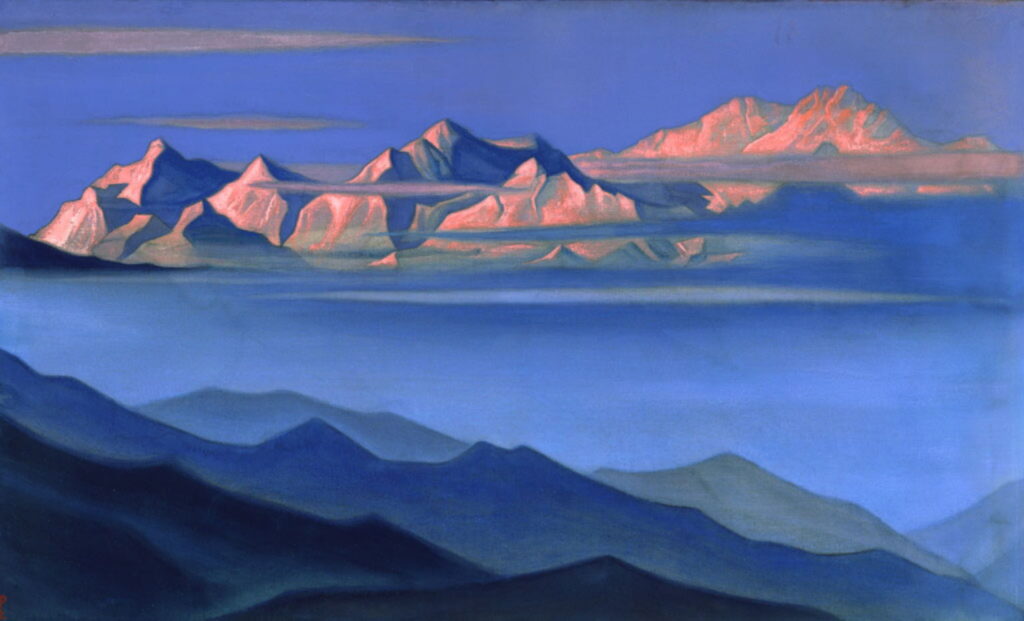High: Contents and locations

This series has included a wide range of paintings showing mountains around the world, their features like glaciers and waterfalls, and some of the people and fauna that live among them. This article lists the mountains and other features covered in each article, together with a brief summary of their contents, with links to full articles in this series.
Salvator Rosa (1615-1673), Rocky Landscape with a Huntsman and Warriors (c 1670), oil on canvas, 142 x 192 cm, Musée du Louvre, Paris. Wikimedia Commons.
This introduction traces the origins of mountain paintings from Salvator Rosa’s romantic imagined mountains with bandits. It identifies Caspar Wolf as making some of the earliest faithful depictions of mountains in around 1774.
Mount Earnslaw, New Zealand, 2,819 m (9,000 ft)
Eiger, Bernese Alps, 3,967 m (13,015 ft)
Kangchenjunga, Eastern Himalaya, 8,586 m (28,169 ft)
Mount Kazbek, Caucasus Mountains, 5,034 m (16,515 ft)
Rosalie Peak, Colorado Rocky Mountains, 4,138 m (13,575 ft)
Triglav III, Julian Alps, Slovenia, 2,864 m (9,400 ft)
Caspar Wolf (1735–1783), The Lauteraar Glacier (1776), oil on canvas, 55 x 82.5 cm, Kunstmuseum Basel, Basel, Switzerland. Wikimedia Commons.
This explains the role of tourists undertaking their Grand Tour across Europe, and covers the period from Caspar Wolf in 1774 to Alexandre Calame in 1855.
Jungfrau, Bernese Alps, Switzerland, 4,158 m (13,642 ft)
This covers the period in which mountains were explored more seriously and surveyed, between 1859-1880. Artists include Albert Bierstadt in the Rocky Mountains, John Turnbull Thomson in New Zealand, Marianne North and Edward Lear in the Himalaya.
Mount Earnslaw, New Zealand, 2,819 m (9,000 ft)
Mount Everest, Himalaya, 8,849 m (29,032 ft)
Kangchenjunga, Eastern Himalaya, 8,586 m (28,169 ft)
Lander’s Peak, Rocky Mountains, 3,187 m (10,456 ft)
Joseph Anton Koch (1768–1839), Grindelwald Glacier in the Alps (1823), oil on canvas, 88.5 x 122.5 cm, Muzeum Narodowe we Wrocławiu, Wrocław, Poland. Wikimedia Commons.
Recession of the Lower Grindelwald Glacier from 1774 to 2009, in paintings and photos, as well as paintings of glaciers elsewhere.
Rosenlaui Glacier, Bernese Alps
Sermitsialik Glacier, Greenland
Vatnajökull Glacier, Iceland
Snæfellsjökull, Iceland
Ferdinand Hodler (1853–1918), The Upper Reichenbach Falls (c 1871), oil on cardboard, 65.5 × 53.5 cm, location not known. Wikimedia Commons.
Spectacular waterfalls, including the Upper Reichenbach Falls, made famous by Sir Arthur Conan Doyle as the setting for the final fight between the fictional detective Sherlock Holmes and the evil Professor Moriarty.
Devil’s Bridge, Saint Gothard Pass, Switzerland
Upper Reichenbach Falls, Switzerland
Staubbach Falls, Switzerland
Yosemite Falls, California
The seasonal migration or transhumance that took many from villages in the valleys up to high pastures for summer grazing of livestock.
The Watzmann, 2,713 m (8,901 ft)
Savognin, Switzerland
Maloja, Engadine, Switzerland
Rax Alps, Austria
Summer pasture and the transhumance
Paul von Franken (1818–1884), Watchtower in the Caucasus (1863), oil on canvas, 47.5 x 66 cm, location not known. Wikimedia Commons.
The Caucasus Mountains on the modern border between Georgia and Russia.
Mount Kazbek, Caucasus Mountains, 5,034 m (16,515 ft)
Dariel Pass, Caucasus Mountains
Paintings by Frederic Edwin Church in 1853-67 following in the footsteps of Alexander von Humboldt in Ecuador.
Mount Chimborazo, Ecuador, 6,263 m (20,548 ft)
Cotopaxi, Ecuador, 5,897 m (19,347 ft)
Pichincha, Ecuador, 4,700 m (15,500 ft)
Edward Lear (1812–1888), Kangchenjunga from Darjeeling (1879), oil on canvas, 119.7 x 182.9 cm, Yale Center for British Art, New Haven, CT. Wikimedia Commons.
Paintings by early visitors to this mountain range, and some by Nicholas Roerich who lived there.
Mount Everest, Himalaya, 8,849 m (29,032 ft)
Kangchenjunga, Eastern Himalaya, 8,586 m (28,169 ft)
The lower but rugged and often isolated mountains of Norway.
Trolltindene, Seven Sisters, Hardanger plateau
Store Skagastølstind, Hurrungane Mountains, Norway, 2,405 m (7,890 ft)
Mountains that are active volcanoes.
Cotopaxi, Ecuador, 5,897 m (19,347 ft)
Mount Fuji, Japan, 3,776 m (12,389 ft)
Mount Merapi, Java, 2,910 m (9,550 ft)
Mount Merbabu, Java, 3,145 m (10,318 ft)
Mount St. Helens, WA, USA, 2,549 m (8,363 ft)
Mount Vesuvius, Italy, 1,281 m (4,203 ft)
Marko Pernhart (1824–1871), Triglav III (date not known), media not known, 58 × 70 cm, Landesmuseum für Kärnten, Klagenfurt, Austria. Wikimedia Commons.
An illustrated account by John Auldjo of his ascent of Mont Blanc in 1827, and paintings by Gabriel Loppé on Mont Blanc in about 1875, and Marko Pernhart on Triglav III.
Mont Blanc, 4,806 m (15,766 ft)
Triglav III, Julian Alps, Slovenia, 2,864 m (9,400 ft)
The Spanish Sierra Nevada mountains, most being views from the Alhambra Palace in Granada.
Mulhacén, Sierra Nevada, Spain, 3,479 m (11,414 ft)
Hot and cold in Spain’s Sierra Nevada
Eugen Bracht (1842–1921), Zugspitze (1916), oil on canvas, 58.3 x 65.5 cm, Private collection. Wikimedia Commons.
A journey crossing the European Alps from the south shore of Lake Geneva in the west, ending up in the Wetterstein Alps on the southern border between Germany and Austria, in the east.
Mont Blanc, 4,806 m (15,766 ft)
Eiger, 3,967 m (13,015 ft)
Fletschhorn, 3,986 m (13,077 ft)
Grammont, 2,172 m (7,126 ft)
Jungfrau, 4,158 m (13,642 ft)
Monte Rosa, 4,634 m (15,203 ft)
Zugspitze, 2,962 m (9,718 ft)
Castles, both real and imaginary.
Chillon Castle, Switzerland
Eltz Castle, Eifel Mountains, Germany
Schloss Neu Bechburg, Önsingen, Switzerland
Birds including eagles and black grouse, and cattle, sheep, deer and goats.
A wide range of chalets, huts and refuges in the Alps and Pyrenees, together with photos of the spectacular Refuge des Grands Mulets (Mont Blanc), and the Solvay Hut (Matterhorn).
Chalus Road (Iran)
Darial Pass (Georgia)
Saint Gothard Pass (Alps)
Great St Bernard Pass (Alps)
Simplon Pass (Alps)
Vikos Gorge (Greece)
John Turnbull Thomson (1821–1884), Mount Earnslaw (New Zealand) (1883), oil on canvas, 67 x 96.5 cm, Hocken Collections, University of Otago, Dunedin City, New Zealand. Wikimedia Commons.
Australia
Victorian Alps, Mount Bogong, 1,986 m (6,516 ft)
Mount Kosciuszko, 2,228 m (7,310 ft)
New Zealand
Mount Earnslaw, 2,819 m (9,000 ft)
Albert Bierstadt (1830–1902), The Rocky Mountains, Lander’s Peak (1863), oil on canvas, 186.7 x 306.7 cm, Metropolitan Museum of Art, New York, NY. Wikimedia Commons.
Bierstadt’s The Rocky Mountains, Lander’s Peak (1863) was one of his most successful paintings based on the studies from his first (1859) visit to the west. This shows a summit of 3,187 metres (10,456 feet), which the surveyors named after a general who died in the Civil War. The First Nation people shown are Shoshone, who Bierstadt recognised would soon only be known in history. He sold this painting in 1865 for the sum of $25,000, at the time a record and in today’s values probably towards half a million dollars.
The Rocky Mountains painted by Albert Bierstadt over the period 1859-1872.
The Hutsul of the Carpathian Mountains, on the borders of Austria, the Czech Republic, Poland, Slovakia, Ukraine, Romania and Serbia
The people of the Engadine in the eastern Swiss Alps.
Alfred de Bréanski (1852-1928), Inverlochy and Ben Nevis (date not known), oil on canvas, 76 × 127 cm, location not known. Wikimedia Commons.
Bidean nam Bian, 1,150 m (3,770 ft)
Ben Chonzie, 931 m (3,054 ft)
Beinn Ìme, 1,011 m (3,317 ft)
Ben Nevis, 1,345 m (4,413 ft)
Rigi Kulm, 1,798 m (5,897 ft)
Aiguille de Blaitière, 3,522 m (11,555 ft)
The Watzmann, 2,713 m (8,901 ft)
Piz Boè, Sella Group, 3,151 m (10,338 ft)
Ellmauer Halt, Wilde Kaiser, at 2,344 m (7,690 ft)



